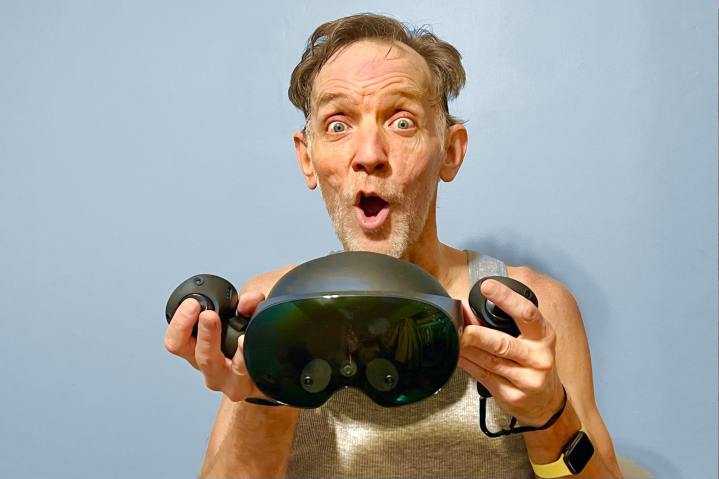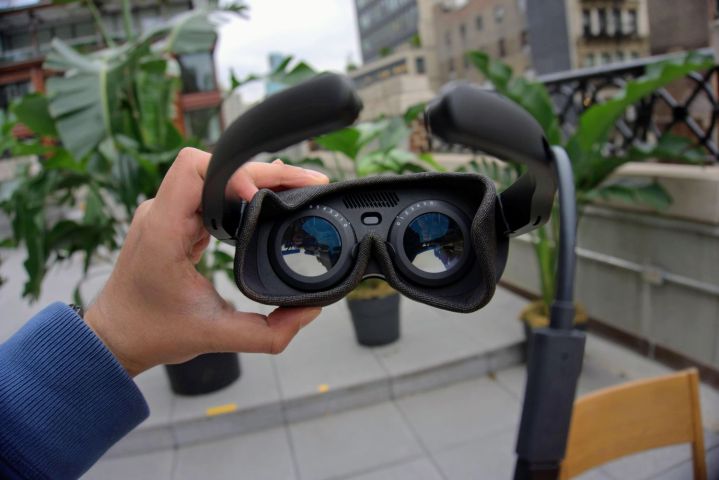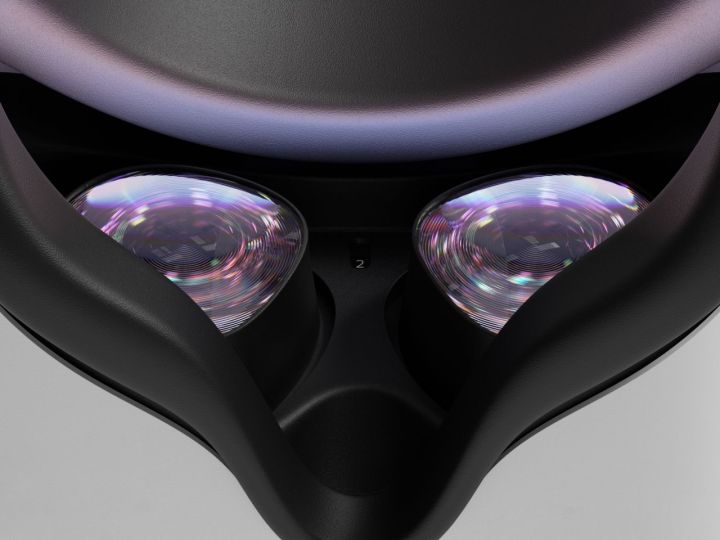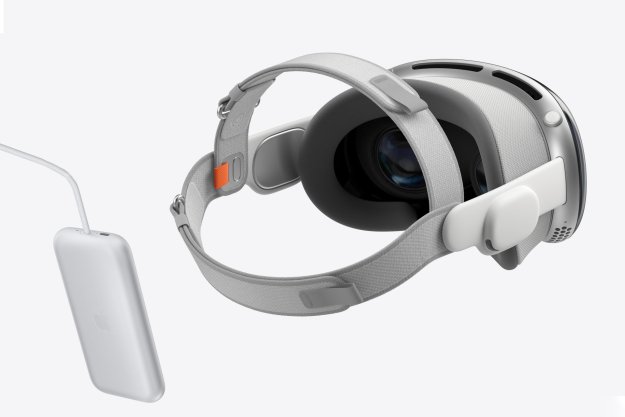VR, or Virtual Reality, is a technology designed to make you feel immersed in a virtual world. It’s a distinctly different feeling than playing a game or navigating a 3D environment on a static 2D monitor, giving a real feeling of presence in the virtual space. This is typically achieved with a VR headset that places one or two displays very close to your eyes, whilst tracking your position so that it can be translated into the virtual world.
The technology has grown and improved in leaps and bounds over the past decade, with the best VR headsets featuring super high-resolution displays, ever-more nuanced motion controls, and even the ability to use them wirelessly.
VR is getting all the more exciting, all the time, but if you want to know where we are and how we got here, here’s a guide to what VR actually is.

What is VR?
Virtual reality technology seeks to create a realistic three-dimensional image or environment that a human can perceive as real, and even interact with in realistic ways. We aren’t at Matrix-like levels of immersion, but the latest generation headsets, games, and virtual experiences can feel incredibly realistic. Even when you’re aware that you’re in a virtual space, it can still be a lot of fun to interact with the world using the natural motion of your body, with motion controls tracking hands, fingers, and even facial expressions with some headsets.
In VR, you can pick up things, throw them, build things, bend down to look at something closely, or lie on your back and stare at the stars. Even looking behind you, rather than always staring straight ahead as you would on a standard monitor or TV, is a novel experience.
This is all achieved with a VR headset, some form of controller, and some kind of tracker so that the game or experience knows where you are and what you’re doing.
How does VR work?
VR works by placing a small screen, typically a high-resolution LCD or OLED monitor, within just a few inches of your eyes. This is then augmented with stereoscopic lenses, distorting the image so that it looks 3D. As you move your head around, the headset tracks your location and orientation, adjusting the in-game visuals accordingly, so that your real-world movements are mimicked in the virtual experience.
This, combined with the all-encompassing view of the headset, and that you can see your motion-tracked hands or other appendages, makes you feel like you’re actually in the virtual world you’re exploring.
This is distinctly different from AR (augmented reality), which overlays virtual objects onto the real world. In AR, there are solid fixed points of reference that your eyes can use to track and navigate. In VR, the full environment is simulated and realism is harder to attain.
Cutting-edge VR projects are working with tactile sensations and even smells, but in the consumer market, VR is typically limited to vision, hearing, and handling simple objects. But you’d be amazed at what can be done with just these senses.

What hardware does VR use?
The most important component in modern-day virtual reality is the VR headset. This piece of hardware typically includes the displays that show the virtual world, the lenses that make it appear 3D to your eyes, and some sort of audio solution, be it speakers or headphones. Most headsets have a comfortable strap mechanism for mounting on your head, and some have built-in cameras for tracking. Others include facial trackers and additional ports for adding accessories.
Some headsets are wired, like the Valve Index, requiring a hard connection to a powerful gaming PC to run, while others, like the Meta Quest 2, are designed to operate independently and have a built-in battery alongside their own processing power. There are older VR headsets designed to work with mobile phones, too, but those are antiquated and largely unused today.
While the headset is, in many cases, the only piece of hardware you absolutely need to enjoy virtual reality, most VR systems also employ other components to make the experience work, or at least make it work better.
- Trackers: Some headsets use what’s known as “inside-out” tracking, where there are depth-sensing cameras on the headset to detect its position, whereas others have external trackers that must be mounted in the corners of the playspace. Every headset includes some form of accelerometer and gyroscope, however, to track the headset’s tilt and orientation.
- Controls: Very simple VR headsets allow basic exploration and interaction with a few buttons located on the headset (especially older, smartphone-driven VR headsets). More advanced headsets offer handheld wand-like controllers, while the most advanced VR systems have more nuanced controllers that can track individual fingers. Some VR setups can track hands and fingers without any kind of hardware controller, and some even offer full-body tracking, so you can use your legs and feet as additional inputs.
- Graphics processor: Virtual reality games and experiences take a lot of processing power to render them realistically, even in low-end headsets. To that end, a VR headset either needs its own onboard processing or needs to be tethered to a powerful system. That can be a desktop PC or laptop, or in the case of the PSVR and PSVR2, a PlayStation console.

What are the different kinds of VR headsets?
You’ll find all the best VR headsets in our companion guide, but that doesn’t cover all the different types of VR headsets that have been released in recent years.
- PCVR: PC VR headsets have been a major point of focus for VR headset makers over the past ten years, with standout early releases like the Oculus Rift and HTC Vive helping to build the industry as it is today. Modern examples include the Valve Index, Pimax 5K Super, and HP Reverb G2. These headsets tend to have the best-looking displays, supporting the highest quality visuals, with the highest refresh rates, and have the best library of games across the Meta store and SteamVR platforms. They can be wired or wireless, can use inside-out, or external tracking, and have a range of controller options. They are almost always the most expensive VR headsets, however, and require a powerful, and expensive gaming PC to run them.
- Console VR: There haven’t been many console virtual reality headsets, but the PlayStation VR (PSVR) and PlayStation VR2 (PSVR2) are two capable options that have proved incredibly popular. They don’t have all the features of the top PCVR headsets, but at release, they have been competitive. They tend to be less expensive than PCVR solutions, but are not cheap, and require a PlayStation 4 or PlayStation 5 to run.
- Standalone VR: Standalone VR headsets have their own internal processing, inside-out tracking, a battery, and wireless motion controllers. They are designed to include absolutely everything you need to get into VR, making them arguably the most accessible way to experience virtual reality. They are limited by battery life, however, and their internal graphics processors aren’t even close to what console and PC VR can offer. That said, they are a lot cheaper, especially since you can discount the cost of needing an external console or PC to power it.
All of these headsets, regardless of their intended use, have varying specifications. These can affect the headset and the end user’s experience of VR in different ways:
- Resolution: This is the number of pixels of the display(s) used in the headset, presented as an equation of the horizontal pixels multiplied by the vertical ones. Higher resolution headsets present crisper visuals to the user, with less jagged edges. Text is more legible, and distant objects are more readily identified. First-generation VR headsets, like the Oculus Rift and HTC Vive, had combined (both eyes) resolutions of 2160 x 1600, while the latest generation headsets, like the Pimax 5K Super have a resolution of 5120 x 1440. There are higher-resolution headsets available, but the higher resolution, the more demand is placed on the graphics processor.
- Refresh rate: This is the number of times that the display can change what it shows per second, given in a Hertz (Hz) rating. Higher refresh rates can lead to smoother animations, but they can also improve immersion and reduce motion sickness. Most VR headsets support a refresh rate of at least 90Hz, though some can support 120Hz, and others still up to 180Hz.
- Field of view: This is how wide the view is within the headset itself. The human eyes have a natural field of view of around 200 to 220 degrees, while most virtual reality headsets only offer up to 110 degrees. This means that there are some black bands down the sides and top and bottom of the view, but this is mostly peripheral. Some headsets support up to 200 degrees, but this is rare. A wider field of view can help you feel more immersion in a game or experience.
- Lenses: There are many different kinds of stereoscopic lenses. Fresnel lenses are some of the most popular, but they have been criticized for having a very small “sweet spot,” where the VR visuals are at their sharpest, and for creating light bloom and “god rays” in high contrast scenes. Many of the latest generation VR headsets use pancake lenses, which are smaller and lighter, as well as reducing the glare found in fresnel lenses. They do not transmit light as efficiently to the user, however, so can result in duller images, or require a much higher brightness from the display to counter it.
- Audio: Different headsets have different audio solutions, with some offering on-ear headphones, and others general speakers which leave your ears open. The latter can make it easier to hear what’s going on around you but isn’t so immersive. Other headsets just include a 3.5mm headphone jack and let you plug in any compatible earbuds or headphones you like. Audio quality can vary dramatically with different headsets, with the Valve Index in particular being lauded for its headphones.
- Comfort: Every headset has its own unique head strap design, its own weight, and its own face plate. That makes the comfort levels of each headset completely different, with some being lightweight and well-balanced, letting you play for hours on end, and others will make your face sore before too long. Lighter headsets tend to be more comfortable, but there’s no guarantee.
- Wired versus wireless: Some headsets are wired, like the Valve Index, requiring a tethered connection to a gaming PC or console and a power source. Others, like the Meta Quest Pro, are entirely self-contained and operate wirelessly. Others, still like the HTC Vive Pro 2, can be upgraded with a wireless kit. In all cases, however, wireless headsets offer more freedom and more immersion, but they do have to worry about battery life, which can limit your playtime. They also tend to be heavier. Wired headsets are certainly simpler, and can offer higher quality, uncompressed visuals, but that wire can remind you that you aren’t in a virtual world, which breaks immersion.
Editors' Recommendations
- Meta has a bold new strategy for VR
- 8K VR comes to the Quest 3
- Meta Quest 4: Here’s what we want from the next big VR headset
- Vision Pro 2: everything we expect from the future of Apple’s headsets
- We have some bad news for Quest owners




